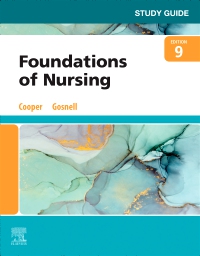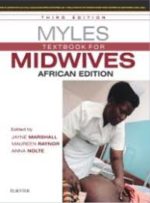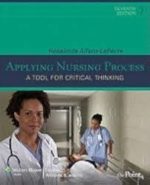Reinforce your understanding of LPN/LVN nursing skills — and prepare for the NCLEX-PN® exam! Corresponding to the chapters in Foundations of Nursing, 9th Edition, this study guide provides a variety of exercises to help you review, practice, and apply nursing concepts and principles. Review questions make it easier to achieve the chapter objectives from the textbook, and critical thinking activities help you develop clinical judgment skills. Now with Next Generation NCLEX® (NGN)-style case studies and questions, this guide provides you with an effective study tool for the NGN exam.
Study Guide for Foundations of Nursing, 9th Edition
KSh 7,280.00
Reinforce your understanding of LPN/LVN nursing skills — and prepare for the NCLEX-PN® exam! Corresponding to the chapters in Foundations of Nursing, 9th Edition, this study guide provides a variety of exercises to help you review, practice, and apply nursing concepts and principles. Review questions make it easier to achieve the chapter objectives from the textbook, and critical thinking activities help you develop clinical judgment skills. Now with Next Generation NCLEX® (NGN)-style case studies and questions, this guide provides you with an effective study tool for the NGN exam.
2 in stock
Related products
-
Myles Textbook for Midwives African Edition, 3rd Edition
KSh 4,914.00The edition of this seminal textbook, Myles Textbook for Midwives, has been extensively revised and restructured to ensure that it reflects current midwifery practice, with an increased focus on topics that are fundamental to midwifery practice today. The book comes with Elsevier EVOLVE ancillaries – an online learning package which consists of 500 self-assessment questions and answers and a fully downloadable image bank.
- Designed to enable midwifery practitioners to provide safe and competent care, which is tailored to the patient’s individual needs
- Extensively illustrated to assist visual learning with additional ‘pull out’ textboxes to highlight key information
- Streamlined chapters with similar themes and approach help consolidate learning
- Reflects all modern midwifery curricula by presenting a strong emphasis on evidenced-based practice and the use of technology
- Over 500 on-line multiple-choice questions to enable readers to test their knowledge
- Offers a full image bank of downloadable illustrations to assist with personal projects and/or further learning
- References, Further Reading and Useful Websites promote further learning
- Glossary of Terms and Acronyms provide simple definitions of more complex terminologies
- Full colour illustrations now used throughout the book, in response to student feedback
- Contains many new chapters, some of which are authored by members of the multi-professional team
- Up-to-date guidance on professional regulation, midwifery supervision, legal and ethical issues, risk management and clinical governance
- Recognition that midwives increasingly care for women with complex health needs, in a multicultural society
- Examination of the dilemmas involved in caring for women with a raised body mass index
- Chapter on optimising care of the perineum for women with perineal trauma, including those who have experienced female genital mutilation
- Guidance to support the trend for midwives to undertake the neonatal physical examination of the healthy term infant
- Additional coverage of basic neonatal resuscitation
-
An Introduction to Forensic Genetics, 2nd Edition
KSh 16,198.00This is a completely revised edition of a comprehensive and popular introduction to the fast moving area of Forensic Genetics. The text begins with key concepts needed to fully appreciate the subject and moves on to examine the latest developments in the field. Now illustrated in full colour throughout, this accessible textbook includes numerous references to relevant casework. With information on the full process of DNA evidence from collection at the scene of a crime to presentation in a legal context this book provides a complete overview of the field.
Key Features:
- Greater in-depth coverage of kinship problems now covered in two separate chapters: one dealing with relationships between living individuals and the other covering identification of human remains.
- New chapter on non-human forensic genetics, including identification of bacteria and viruses, animals and plants.
-
Rehabilitation Techniques for Sports Medicine and Athletic Training 7th Edition
KSh 17,850.00Rehabilitation Techniques for Sports Medicine and Athletic Training, Seventh Edition is the definitive reference for athletic training students and professionals who are interested in gaining more in-depth exposure to the theory and practical application of rehabilitation techniques used in a sports medicine environment.
Dr. William Prentice and his contributors have combined their knowledge and expertise to produce a single text that encompasses all aspects of sports medicine rehabilitation. Featuring more than 1,000 full-color illustrations, 700 high-resolution videos, and an integrated laboratory manual, this newly updated Seventh Edition provides the athletic trainer with a complete guide to the design, implementation, and supervision of rehabilitation programs for sport-related injuries.
The Seventh Edition includes new and updated information on topics including:
• Pharmacology and the role of medication in pain management and performance
• Nutrition and its impact on rehabilitation
• Rehabilitation techniques for the core
• Roles within the rehabilitation team
• Pathomechanics and epidemiology of common injuries
• Psychological considerations and communication with injured patients
• Tips for documentation from Dr. Prentice -
Myles Textbook for Midwives, International Edition, 17th Edition
KSh 5,642.00Written by midwives for midwives, Myles Textbook for Midwives has been the seminal textbook of midwifery for over 60 years. It offers comprehensive coverage of topics fundamental to 21st midwifery practice. Co-edited for the second time, by internationally renowned midwife educationalists, Professor Jayne E Marshall and Maureen D Raynor from the United Kingdom with a team of contributors from across the midwifery community it retains its clear, accessible writing style. Most chapters provide useful case studies, websites of key organisations and charities for individuals to access further information. Reflective questions at the end of each chapter as well as annotated further reading aid reflective learning and stimulate discussions relating to continuing professional development.
Key Features-
- The book covers key frameworks that govern midwifery practice, exploring ethical and legal frameworks that are essential to every accountable, autonomous, professional midwife.
-
- Includes employer-led models of supervision, vital elements of leadership and clinical governance that supports the provision of high quality maternity services and standards of midwifery practice.
-
- The concept of resilience is introduced for the reader to contemplate their personal contribution in creating an environment that is conducive to protecting the wellbeing of themselves and colleagues within the workplace.
-
- The text covers the UN 2030 Agenda for Sustainable Development, highlighting the importance of midwives as global citizens with common goals, and together they form a strong global community prepared to challenge social inequalities and take action to help end extreme poverty.
-
- Covers designing and implementing high quality midwifery care using evidence, policy and models of care. Highlights why a holistic and evidence-informed approach is necessary to achieve effective care for all. Working examples will help the reader to think critically about their own practice.
-
- For this edition several new chapters are introduced covering concealed pregnancy, fear of childbirth (tocophobia), care of the acutely unwell woman and end of life issues including rights of the fetus/neonate and ethical considerations.
Author InformationEdited by Jayne E. Marshall, FRCM, PFHEA, PhD, MA, PGCEA, ADM, RM, RN, Foundation Professor of Midwifery and NMC Lead Midwife for Education, School of Allied Health Professions, College of Life Sciences, George Davies Centre, University of Leicester, UK and Maureen D. Raynor, MA PGCEA ADM RMN RN RM, Senior Lecturer (Midwifery), De Montfort University, Faculty of Health and Life Sciences, School of Nursing and Midwifery, Leicester, UK -
-
Essentials of Anatomy and Physiology for Nursing Practice
KSh 7,280.00Effective, holistic nursing is impossible without a firm grasp of how the human body functions, but knowledge of the scientific theory on its own is not enough. Written with the needs of nurses firmly in mind and using the person-centred practice framework as a guiding principle, this book brings anatomy and physiology to life, combining the best of print and online learning into one integrated package. Key features: Connects theory with nursing practice by exploring the science from the perspective of a fictional family Uses a rich array of full-color figures, diagrams, and video material including interactive figures, animations and mini-tutorials – perfect for visual learners Full of engaging activities designed to complement self-directed learning. Supported by a collection of digital resources, including 170 online multiple choice questions, over 800 revision flashcards, and complete access to videos, animations, revision material and action plans. Ideal for revision and consolidating knowledge. Visit https://edge.sagepub.com/essentialaandp to find out more. Get 12 months FREE access to an interactive eBook* when you buy the paperback! (Print paperback version only, ISBN 9781473938465) Each purchase includes 12 months access to an interactive eBook version, meaning you can study when and how you want and make use of additional tools including search, highlighting, annotation note sharing and much more. *interactivity only available through Vitalsource eBook
-
Applying the Nursing Process: A Tool for Critical Thinking
KSh 17,835.00This trusted resource combines the practical guidance students need to understand each phase of the nursing process with an emphasis on critical thinking, focusing on both independent and collaborative responsibilities facing today’s nurses. Using straightforward language, abundant examples, and real case scenarios, the book addresses the nurse’s role as a caregiver and decision-maker in a range of settingsfrom clinic to the home, community, research, and acute care arenas. A new focus and design help readers build essential critical thinking and problem solving skills and apply them within the nursing process framework.
A companion Website provides a variety of tools such as patient self-assessment tool, clinical decision map, NCLEX® resources, and much more.
-
Pocket book of hospital care for children
KSh 3,640.00This is the second edition of the Pocket book of hospital care for children. It is for use by doctors, nurses and other health workers who are responsible for the care of young children at the first level referral hospitals. The Pocket Book is one of a series of documents and tools that support the Integrated Management of Childhood Illness (IMCI). It is an update of the 2005 edition, and presents up-to-date evidence based clinical guidelines from several recently updated and published WHO guidelines and recommendations. The guidelines are for use in both inpatient and outpatient care in hospitals with basic laboratory facilities and essential medicines. These guidelines focus on the management of the major causes of childhood mortality in most developing countries, such as newborn problems, pneumonia, diarrhoea, malaria, meningitis, septicaemia, measles and related conditions, severe acute malnutrition and paediatric HIV/AIDS. It also covers common procedures, patient monitoring and supportive care on the wards and some common surgical conditions that can be managed in small hospitals.
Details of the evidence on which the Pocket Book is based can be found on the WHO website from the relevant published guidelines provided in the bibliography. This bedside paediatric care guidelines are applicable in most areas of the world and may be adapted to suit country specific circumstances. However, advanced and high care treatment options, such as intensive care or mechanical ventilation, are not described. The Pocket Book is also available in hard copies although the online version will be updated regularly as new evidence emerges.
-
Wong’s Essentials of Pediatric Nursing
Awarded first place in the 2017 AJN Book of the Year Awards in the Child Health category. Known for its accuracy, evidence-based focus, and engaging writing style, Wong’s Essentials of Pediatric Nursing, 10th Edition has been the #1 title in the pediatric nursing market since it first published in 1980! Thoroughly revised to equip you with the latest research and guidelines for treating children today, it encourages a whole-body approach by beginning with child development and health promotion to better understand the later chapters on specific health problems. A new chapter featuring all systems cancers provides comprehensive information in one place. Nursing Care Plans now incorporate additional case studies to personalize interventions and promote critical thinking.
A developmental approach clearly identifies key tasks, influences, and differences at each stage of a child’s growth to help students provide appropriate, individualized care for each child.
UNIQUE! Critical thinking case studies allow you to test and develop your analytical skills in a variety of clinical situations.
UNIQUE! Quality Patient Outcomes content in Nursing Care Management discussions for major diseases and disorders helps you understand how the care you provide directly impacts patient safety and promotes positive outcomes.
Updated genetic content in the Developmental and Genetic Influences on Children chapter addresses rapidly changing and important information as it relates to children in health and illness.
UNIQUE! Family focus includes a separate chapter on the role of the family in child health, family content throughout the text, and Family-Centered Care boxes that highlight information on patient teaching, home care, and incorporating the family in the child’s care.
UNIQUE! Translating Evidence into Practice boxes focus your attention on the application of research and critical thought processes to support and guide the outcomes of nursing care.
UNIQUE! Atraumatic Care boxes guide you through performing procedures in a caring manner, promoting more positive experiences for children, families, and nurses.
Drug Alerts throughout the text emphasize important drug information and point out potential safety issues.
An emphasis on wellness offers health promotion and injury prevention strategies for each age group.
Community Focus boxes provide resources and guidance on caring for children outside the clinical setting.
Nursing Care Plans, including Nursing Diagnoses, Patient/Family Goals, Nursing Interventions/Rationales, and Expec1ted Outcomes, provide you with a model for planning patient care.
Research Focus boxes help you remain abreast of current studies that impact pediatric nursing today.
Cultural content, integrated throughout the text and highlighted in Cultural Considerations boxes, exposes you to customs and beliefs of different cultures that influence child care, enhancing your ability to provide quality nursing care to ALL children and their families.
Nursing Tips throughout the text offer helpful hints and practical, clinical information of a non-emergency nature.
Nursing Alerts throughout the text provide you with critical information that must be considered in providing care.
UNIQUE! Emergency Treatment boxes serve as a quick reference in critical situations.
Nursing Care Guidelines boxes provide you with clear, step-by-step, detailed instructions for performing specific skills or procedures.
NEW! Updated content throughout, notably methods of measuring competency and outcomes (QSEN and others), ambiguous genitalia, pediatric measurements, guidelines, and standards as defined by the American Academy of Pediatrics, and clear definitions of adolescent and young adult, keeps you up-to-date on important topic areas.
NEW! The Child with Cancer chapter includes all systems cancers for ease of access.
NEW and UPDATED! Case Studies now linked to Nursing Care Plans to personalize interventions, while also providing questions to promote critical thinking.










Be the first to review “Study Guide for Foundations of Nursing, 9th Edition”